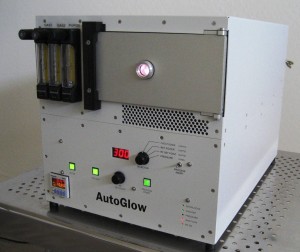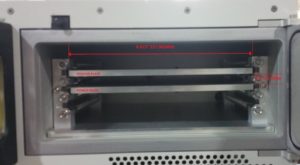
Up to 300 watts or optional 600 watt generator
Plasma Cleaning Prior to Wire Bonding
Plasma cleaning prior wire bonding and plasma technology is often characterized as a “dry” plasma cleaning process, using ionized gases in vacuum chambers. Typically these oxides are very thin, and if left on bond pads, could contribute to bond strength degradation in both wire bonding and gold bump flip chip applications. Plasma Cleaning Prior to Wire Bonding and Gold Bump Plasma cleaning can remove contaminants to improve yields in gold bonding processes.
- The surface modification deals with altering the molecular makeup of the substrate and die surfaces of interest.
- Plasma cleaning prior to wire bonding, and plasma treatment in this application will result in a rougher surface that becomes more hydrophilic, thus improving underfill and encapsulant wetting and adhesion.
Contamination on Gold Bond Pads
Die attach and subsequent adhesive cure steps can cause contamination to form on substrate or package gold bond pads. Untreated, this can lead to no-sticks or low ball shear at the wire bonding operation. Oftentimes the wire bonder is thought to be faulty. The use of plasma cleaning also extends to gold stud bump flip chip bonding. Studies prove that Ar plasma treatment improves the die shear strength of these joints as well.
Plasma Surface Modification
- Oxygen plasma cleaning improves adhesion of fluids to substrates, namely underfills and encapsulants. For example, an untreated substrate surface may be hydrophobic, causing voids and/or slow underfill wetting. Unlike unreactive argon gas, oxygen plasma breaks down into O+ ions and neutral O radicals where the radicals are of main interest.
- Unaffected by the electric field in the chamber, these highly reactive species find their way under flip chip gaps.
- This is key, because it is precisely the area where chemical functionalization needs to occur.
- The radicals graft additional molecular structures on the surface of the substrate and bottom of die, which appear as a roughening or texturing.
- Thus resulting in a more hydrophilic surface as shown by water contact angle measurements.
Conclusion
Plasma cleaning prior wire bonding and and surface modification technology is a necessary step in the microelectronics assembly process. Argon plasma in a parallel plate (RIE) vacuum chamber design has proven effective at removing nickel compounds from gold bond pad surfaces. As engineers look to reduce Au plating thicknesses to save on material costs, the propensity for nickel migration increases and thus the need to remove these surface impurities by plasma treatment. With Au thicknesses down to 50nm (2 <µin) being introduced, an objective review of the plasma cleaning method in place is important to insure quality remains high in the wire bonding and flip chip attach steps.
The AutoGlow 200 can be used for plasma cleaning prior to bonding. Placing samples on bottom shelf will allow for a more aggressive reaction when using Ar or other process gases (see below):

Place Sample on Bottom Powered Shelf for Ion Assisted Reaction
For a less aggressive reaction, configure the ground shelf below the powered shelf–then place your samples on the grounded electrode (see below):

For a less aggressive process, place the ground shelf below the powered shelf
Some Customers report good results by placing samples on the very bottom of the chamber with the above configuration. The bottom of the chamber will be a floating ground.
We have Customers that also use the GLOW system for cleaning/treatment prior to wire bonding. Most Customers use argon gas for this application. Click here for more information on the GLOW plasma system.

GLOW Plasma System with three different powered shelves.

GLOW plasma system sample carrier with three different electrode shelves

AutoGlow 1000 with large chamber for production needs
Paper from Research Gate…Effects of plasma cleaning on the reliability of wire bonding: click HERE
